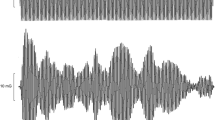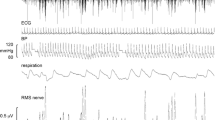Abstract
We have previously shown that sinusoidal galvanic vestibular stimulation, a means of selectively modulating vestibular afferent activity, can cause partial entrainment of sympathetic outflow to muscle and skin in human subjects. However, it influences the firing of afferents from the entire vestibular apparatus, including the semicircular canals. Here, we tested the hypothesis that selective stimulation of one set of otolithic organs—those located in the utricle, which are sensitive to displacement in the horizontal axis—could entrain sympathetic nerve activity. Skin sympathetic nerve activity (SSNA) was recorded via tungsten microelectrodes inserted into cutaneous fascicles of the common peroneal nerve in 10 awake subjects, seated (head vertical, eyes closed) on a motorised platform. Slow sinusoidal accelerations–decelerations (~4 mG) were applied in the X (antero-posterior) or Y (medio-lateral) direction at 0.08 Hz; composite movements in both directions were also applied. Subjects either reported feeling a vague sense of movement (with no sense of direction) or no movement at all. Nevertheless, cross-correlation analysis revealed a marked entrainment of SSNA for all types of movements: vestibular modulation was 97 ± 3 % for movements in the X axis and 91 ± 5 % for displacements in the Y axis. For each sinusoidal cycle, there were two major peaks of modulation—one associated with acceleration as the platform moved forward or to the side, and one associated with acceleration in the opposite direction. We interpret these observations as reflecting inertial displacement of the stereocilia within the utricle during acceleration, which causes a robust vestibulosympathetic reflex.



Similar content being viewed by others
References
Balaban CD, Beryozkin G (1994) Vestibular nucleus projections to nucleus tractus solitarius and the dorsal motor nucleus of the vagus nerve: potential substrates for vestibulo-autonomic interactions. Exp Brain Res 98:200–212
Bent L, Bolton P, Macefield V (2006) Modulation of muscle sympathetic bursts by sinusoidal galvanic vestibular stimulation in human subjects. Exp Brain Res 174:701–711
Bini G, Hagbarth K-E, Wallin BG (1981) Cardiac rhythmicity of skin sympathetic activity recorded from peripheral nerves in man. J Auton Nerv Syst 4:17–24
Cathers I, Day BL, Fitzpatrick RC (2005) Otolith and canal reflexes in human standing. J Physiol 563:229–234
Cohen B, Martinelli GP, Ogorodnikov D, Xiang Y, Raphan T, Holstein GR, Yakushin SB (2011) Sinusoidal galvanic vestibular stimulation (sGVS) induces a vasovagal response in the rat. Exp Brain Res 210:45–55
Cohen B, Yakushin SB, Holstein GR (2012) What does galvanic vestibular stimulation actually activate? Front Neurol 2:90
Costa F, Lavin P, Robertson D, Biaggioni I (1995) Effect of neurovestibular stimulation on autonomic regulation. Clin Auton Res 5:289–293
Cui J, Mukai C, Iwase S, Sawasaki N, Kitazawa H, Mano T, Sugiyama Y, Wada Y (1997) Response to vestibular stimulation of sympathetic outflow to muscle in humans. J Auton Nerv Syst 66:154–162
Cui J, Iwase S, Mano T, Kitazawa H (1999) Responses of sympathetic outflow to skin during caloric stimulation in humans. Am J Physiol Regul Integr Comp Physiol 276:738–744
Cui J, Iwase S, Mano T, Katayama N, Mori S (2001) Muscle sympathetic outflow during horizontal linear acceleration in humans. Am J Physiol Regul Integr Comp Physiol 281:625–634
Delius W, Hagbarth K-E, Hongell A, Wallin BG (1972) Manouevres affecting sympathetic outflow in human skin nerves. Acta Physiol Scand 84:177–186
Doba N, Reis D (1974) Role of cerebellum and the vestibular apparatus in regulation of orthostatic reflexes in cat. J Am Heart Found 34:9–18
Eatock RA, Songer JE (2011) Vestibular hair cells and afferents: two channels for head motion signals. Annu Rev Neurosci 34:501–534
Eatock RA, Hurley KM, Vollrath MA (2002) Mechanoelectrical and voltage-gated ion channels in mammalian vestibular hair cells. Audiol Neuro-Otol 7:31–35
Eron JN, Cohen B, Raphan T, Yakushin SB (2008) Adaptation of orientation vectors of otolith-related central vestibular neurons to gravity. J Neurophysiol 100:1686–1690
Fernández C, Goldberg JM (1976) Physiology of peripheral neurons innervating otolith organs of the squirrel monkey. II. Directional selectivity and force-response relations. J Neurophysiol 39:985–995
Fitzpatrick RC, Day BL (2004) Probing the human vestibular system using galvanic stimulation. J Appl Physiol 96:2301–2316
Gacek RR (1979) Vestibular neuroanatomy. Recent observations. Ann Otol Rhinol Laryngol 88:667–675
Goldberg JM, Smith CE, Fernandez C (1984) Relation between discharge regularity and responses to externally applied galvanic currents in vestibular nerve afferents of the squirrel monkey. J Neurophysiol 51:1236–1256
Grewal T, James C, Macefield V (2009) Frequency-dependent modulation of muscle sympathetic nerve activity by sinusoidal galvanic vestibular stimulation in human subjects. Exp Brain Res 197:379–386
Hammam E, James C, Dawood T, Macefield VG (2011) Low-frequency sinusoidal galvanic stimulation of the left and right vestibular nerves reveals two peaks of modulation in muscle sympathetic nerve activity. Exp Brain Res 213:507–514
Hammam E, Dawood T, Macefield VG (2012) Low-frequency galvanic vestibular stimulation evokes two peaks of modulation in skin sympathetic nerve activity. Exp Brain Res (in press)
Holstein GR, Friedrich VL Jr, Martinelli GP, Ogorodnikov D, Yakushin SB, Cohen B (2012) Fos expression in neurons of the rat vestibulo-autonomic pathway activated by sinusoidal galvanic vestibular stimulation. Front Neurol 3:4
Hume KM, Ray CA (1999) Sympathetic responses to head-down rotations in humans. J Appl Physiol 86:1971–1976
James C, Macefield VG (2010) Competitive interactions between vestibular and cardiac rhythms in the modulation of muscle sympathetic nerve activity. Auton Neurosci 158:127–131
James C, Stathis A, Macefield VG (2010) Vestibular and pulse-related modulation of skin sympathetic nerve activity during sinusoidal galvanic vestibular stimulation in human subjects. Exp Brain Res 202:291–298
Jian BJ, Acernese AW, Lorenzo J, Card JP, Yates BJ (2005) Afferent pathways to the region of the vestibular nuclei that participates in cardiovascular and respiratory control. Brain Res 1044:241–250
Kaufmann H, Biaggioni I, Voustianiouk A, Diedrich A, Costa F, Clarke R, Gizzi M, Raphan T, Cohen B (2002) Vestibular control of sympathetic activity. An otolith-sympathetic reflex in humans. Exp Brain Res 143:463–469
Kerman IA, Yates BJ, McAllen RM (2000) Anatomic patterning in the expression of vestibulosympathetic reflexes. Am J Physiol Regul Integr Comp Physiol 279:109–117
Macefield VG, Wallin BG (1995) Effects of static lung inflation on sympathetic activity in human muscle nerves at rest and during asphyxia. J Autonom Nerv Sys 53:148–156
Macefield VG, Wallin BG (1999) Respiratory and cardiac modulation of single vasoconstrictor and sudomotor neurones to human skin. J Physiol 516:303–314
Minor LB, Goldberg JM (1991) Vestibular-nerve inputs to the vestibulo-ocular reflex: a functional ablation study in the squirrel monkey. J Neurosci 11:1636–1648
Porter JD, Balaban CD (1997) Connections between the vestibular nuclei and brain stem regions that mediate autonomic function in the rat. J Vestib Res 7:63–76
Ray CA, Hume KM, Steele SL (1998) Sympathetic nerve activity during natural stimulation of horizontal semicircular canals in humans. Am J Physiol Regul Integr Comp Physiol 275:R1274–R1278
Shortt TL, Ray CA (1997) Sympathetic and vascular responses to head-down neck flexion in humans. Am J Physiol Heart Circ Physiol 272:1780–1784
Yakushin SB, Raphan T, Cohen B (2006) Spatial properties of central vestibular neurons. J Neurophysiol 95:464–478
Yates BJ, Miller AD (1994) Properties of sympathetic reflexes elicited by natural vestibular stimulation: implications for cardiovascular control. J Neurophysiol 71:2087–2092
Yates BJ, Yamagata Y, Bolton PS (1991) The ventrolateral medulla of the cat mediates vestibulosympathetic reflexes. Brain Res 552:265–272
Yates BJ, Goto T, Bolton PS (1993) Responses of neurons in the rostral ventrolateral medulla of the cat to natural vestibular stimulation. Brain Res 601:255–264
Yates BJ, Grélot L, Kerman IA, Balaban CD, Jakus J, Miller AD (1994) Organization of vestibular inputs to nucleus tractus solitarius and adjacent structures in cat brain stem. Am J Physiol Regul Integr Comp Physiol 267:974–983
Yates BJ, Balaban CD, Miller AD, Endo K, Yamaguchi Y (1995) Vestibular inputs to the lateral tegmental field of the cat: Potential role in autonomic control. Brain Res 689:197–206
Acknowledgments
This work was supported by a grant from the Australian Research Council to KK and VGM (ARC DP 1096179). The motion simulator was fabricated by the Hong Kong University of Science & Technology.
Author information
Authors and Affiliations
Corresponding author
Rights and permissions
About this article
Cite this article
Grewal, T., Dawood, T., Hammam, E. et al. Low-frequency physiological activation of the vestibular utricle causes biphasic modulation of skin sympathetic nerve activity in humans. Exp Brain Res 220, 101–108 (2012). https://doi.org/10.1007/s00221-012-3118-4
Received:
Accepted:
Published:
Issue Date:
DOI: https://doi.org/10.1007/s00221-012-3118-4




